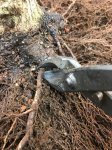Random User
Guest
- Messages
- 1,313
- Reaction score
- 1,170
No, I never thought of that... my gut tells me, that doing so might make the robins even happier!... ha ha!
I could always "thief proof" the top of the soil with chicken wire, but I think the birds are much more of a help than a hinderance as they are foraging... I'll try a tree or two as you suggest next spring... it might work.
Thanks.
I could always "thief proof" the top of the soil with chicken wire, but I think the birds are much more of a help than a hinderance as they are foraging... I'll try a tree or two as you suggest next spring... it might work.
Thanks.
















